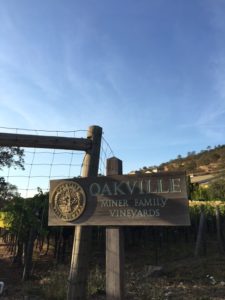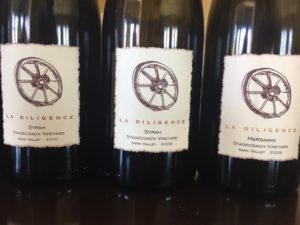ON A HILLSIDE ABOVE OAKVILLE, Dave Miner and company sit in cabernet’s catbird seat.
It’s carved into a rocky slope that faces west down to the Silverado Trail, where the Napa Valley floor displays hardly a patch of green canopy that isn’t planted to the traditional varieties of Bordeaux. The neatly divided blocks of Oakville are verdant with cabernet sauvignon, merlot, and cabernet franc, the vines that tie Napa Valley and California to France’s most famous wine region.
Miner Family Winery is perched in the Oakville AVA with a view across a section of the valley that a friend of mine, the wine merchant Rhett Gadke, once called “the Rodeo Drive of Napa Valley.” The analogy fits, since so many of the cabernet-based wines produced here command Beverly Hills prices. Although Dave Miner’s Oakville cabernet sauvignon isn’t exactly cheap, compared to most of his neighbors’ price tags, it’s more Silver Lake bottle shop than Beverly Hills boutique.
On the shelves of said boutiques, or at winery cellar doors, many Oakville cabernets and red blends cost as much as the top wines from Left and Right Bank Bordeaux. Dave Miner doesn’t shy away from the comparison—just the $200-per-bottle prices.
The approximate term “Bordeaux blend” is often used by Napa Valley and other domestic wineries that make wines from Bordeaux grape varieties. At Miner Family, they get straight to the point: of the menu choices on the “Wines” page of their website, one takes you to cabernet sauvignon, merlot, and cabernet franc, i.e. the “Bordeaux style” wines produced by head winemaker Gary Brookman. On another page, Miner’s “Burgundy style” pinot noir and chardonnay are found.
These Bordeaux- and Burgundy-style wines turned out by Gary and his team for the last 20-odd years have always struck me as polished and very well-made. They show what fruit-forward but balanced winemaking can look like in the Napa Valley, Carneros, and Santa Lucia Highlands fruit Miner uses for these wines.
But the third French region listed on the website has always been the one that most intrigues me: the “Rhône Style” page.
• • • • •
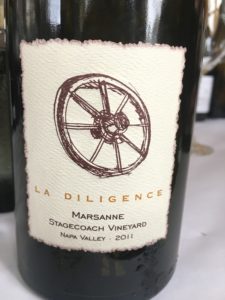 On one of the few mild days in Napa Valley this past July, I headed to Oakville for a visit to Dave Miner’s winery. It was just before lunchtime on a weekday, and summer guest traffic was light in the normally busy tasting room as I arrived and made my way upstairs to meet with Dave. We were joined by his good friend and former sales director turned French wine importer, Jack Edwards. In my salesman’s bag rode a slightly older bottle of a Miner Rhône-style white wine that I wanted them both to try.
On one of the few mild days in Napa Valley this past July, I headed to Oakville for a visit to Dave Miner’s winery. It was just before lunchtime on a weekday, and summer guest traffic was light in the normally busy tasting room as I arrived and made my way upstairs to meet with Dave. We were joined by his good friend and former sales director turned French wine importer, Jack Edwards. In my salesman’s bag rode a slightly older bottle of a Miner Rhône-style white wine that I wanted them both to try.
The wine was quite familiar to Jack, who helped arrange the meeting: a 2011 Stagecoach Vineyard marsanne, made at Miner under the winery’s former second label, La Diligence. Jack had been instrumental in the label’s creation while running the winery’s sales and was curious to taste this bottle.
Producing a dry, rich, medium-bodied wine, the marsanne grape fits neatly into Miner’s Rhône-style category. In France, it’s one of the two varieties (the other being roussanne) grown for the white Rhône Valley appellations of Saint-Joseph, Crozes-Hermitage, and Saint-Péray. And, most prominently, it plays a starring role in Hermitage blanc, one of France’s finest whites.
Jack and I seated ourselves at a table in a high-ceilinged meeting room, its wide windows displaying the Oakville and Rutherford panorama to the west, framed by the Mayacamas Mountains. Dave walked in carrying a couple bottles of his own and sporting a t-shirt, shorts and—to complete the winery owner’s summer ensemble—flip-flops. He got the conversation started in jarring fashion when the cold bottle of marsanne I’d just handed  him slipped from his fingers and bounced to the floor, missing his uncovered foot by two inches. “I’m glad that didn’t hit my toe!” he laughed. I did, too, but cried a little on the inside at the thought of my host’s narrowly avoided agony or, almost as bad, a shattered bottle of this precious wine.
him slipped from his fingers and bounced to the floor, missing his uncovered foot by two inches. “I’m glad that didn’t hit my toe!” he laughed. I did, too, but cried a little on the inside at the thought of my host’s narrowly avoided agony or, almost as bad, a shattered bottle of this precious wine.
The 2011 La Diligence marsanne was rare not just for its library status at Miner, but because it was the last of a brief run of white wine vintages under the second label. Along with this unusual variety, the winery purchased more conventional syrah fruit from Stagecoach Vineyard and with it produced attention-grabbing red wine during nine harvests from 2004 to 2012. For their own reasons, they discontinued the label after that last vintage and folded it back into the Miner program.
I’d say Dave and his people went out with a bang, if only a quiet one. Together, the white and red La Diligence bottlings comprised one of the more exciting Rhône-specific labels I’ve seen in California over the last 25 years. I think I was taken with the marsanne in particular because it reminded me of another time in my wine-drinking life, which I’ll get to in part two.
“We decided to have this partnership between two wineries: one guy from France and us here in California,” Dave began to explain, carefully picking up the bottle and pulling the cork. He worked backwards on the Diligence timeline, recounting as he poured out three glasses of the marsanne why this ’11 vintage was the last of it. “We thought it would help draw some interest to Rhône grapes. And it was never a problem selling these wines to sommeliers.”
Dave’s “guy from France” was the northern Rhône Valley winemaker, François Villard, of whom I’ve written before on this site. The Frenchman is a friend to both Dave and Jack and also something more: an adventurous, California-enamored soul brother to a couple of well-traveled Rhône experts. As a leading producer of the genuine Rhône Valley article who has made himself both familiar and accessible in this country, he’s a favorite of many U.S. restaurant and retail buyers. François is, in a way, the perfect restaurant winemaker: sommeliers tend to want to discuss their wine selections with their guests, and his are ultra-focused examples of the northern Rhône that merit an informed steering away from the cabernet and chardonnay pages of a wine list.
In the early 2000s, the Miner guys connected with François and his colleague, Yves Cuilleron, at the Hospices de Rhône festivals in Paso Robles. The French vignerons had come all the way to California to promote the northern Rhône at these party-like events and were naturally curious to venture up to Napa Valley, where they would find welcoming hosts in Dave and Jack (and would, as is their wont, bring some of the party with them to Oakville).
At the 2002 Hospices festival, Dave and Jack found themselves at a restaurant bar on the Paso Robles town square drinking with François, their new vigneron friend. Jack joked that tequila was their international language, as there was a decided French-English barrier. “At that time, François didn’t speak one word of English, and Dave and I didn’t speak any French. And after a few margaritas, we were having a full-on conversation about making wine together.”
He added that Yves Cuilleron and his fellow Rhône vigneron, Yves Gangloff, were “probably” there, as well, and may have contributed some ideas. But he wasn’t entirely sure. “All I remember is sitting at the bar with François with a couple of margaritas in our hands and deciding we were going to make some wine together in Napa, and that’s how it started. I mean, we actually remembered the next day and continued the conversation. Then they came to Napa the next year, and that’s how we kicked it off.”
Around the time this margarita-fueled side project was conceived of, Jack found out about a parcel of syrah fruit available in Jan Krupp’s mountainous Stagecoach Vineyard, high up on Pritchard Hill overlooking Oakville. With Dave’s blessing and the Rhône winemakers’ consultation, La Diligence—the French word for “stagecoach”—was born in the 2004 vintage.
“So Pierre Gangloff drew the wagon wheel that’s on the label,” Jack said, explaining the unusual name. “Pierre is Yves Gangloff’s brother. He’s an artist. For the name, we couldn’t think of anything at all. I remember going around the Hospices du Rhône at the big tasting on the Saturday one day, and I said to François, ‘How do you say ‘stagecoach’ in French, and he said, ‘la diligence,’ and I was like, ‘That’s it!’” 
Jack detailed the Frenchmen’s early involvement in the actual winemaking. “They would come just before harvest to check the vineyards and talk to us about what they wanted to do as far as whole cluster fermentation, and using stems, and what kind of barrels, and all that kind of stuff. Then they would come back in the spring and taste the wine.”
He referred specifically to the Stagecoach Vineyard syrah, which stood alone as a variety for Diligence’s first four vintages. Conveniently, Dave had brought up bottles of 2008 and ’10 La Diligence syrah from the winery cellar for us to taste. As I pulled out my corkscrew to help open them, I asked him what he, Jack, and the French winemakers initially saw in Stagecoach in terms of its potential to grow legitimately Rhône-style wines when the Napa and Rhône Valleys were such different locations with unique climates.
“With all of this fruit coming from Stagecoach Vineyard, I think François and Yves really liked the rocky, volcanic soil,” Dave said. “I mean it’s not granitic soil, and it’s not schist, but it has a similar profile. I think the idea really was to try to make something that was incredibly French stylistically, but from California soil.”
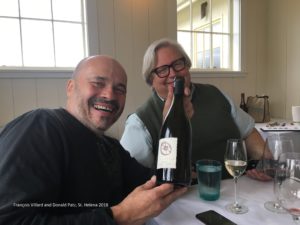 The initial syrah vintages under the second label were successful enough to inspire Dave and his partners to consider other opportunities in Stagecoach Vineyard. “We wanted to do more white Rhône varietal stuff, and Jan Krupp had marsanne, roussanne, and some viognier up on Stagecoach and didn’t have a lot of takers. So I kind of said, ‘Well, let’s do some marsanne under the Diligence label too,’ and François said, ‘Sure, let’s do it.’”
The initial syrah vintages under the second label were successful enough to inspire Dave and his partners to consider other opportunities in Stagecoach Vineyard. “We wanted to do more white Rhône varietal stuff, and Jan Krupp had marsanne, roussanne, and some viognier up on Stagecoach and didn’t have a lot of takers. So I kind of said, ‘Well, let’s do some marsanne under the Diligence label too,’ and François said, ‘Sure, let’s do it.’”
• • • • •
Reversing the cross-Atlantic trek, Dave and Jack soon traveled to France and the Rhône Valley, once La Diligence had a couple vintages of syrah in the bottle that they could use as calling cards. This was before they started buying marsanne fruit from Krupp. Guided by François to professional trade shows in the northern Rhône wine hub of Ampuis, just south of Lyon, or to his fellow winemakers’ homes and wineries, they had the unique opportunity to demonstrate syrah’s Napa Valley potential right on its home turf. It might have ended badly, or at least discouragingly, but their efforts were met with approval by François’ colleagues. It was, anyway, the Rhône vigneron version of approval.
“When we went and tasted the wines with all their friends in Ampuis or wherever, we’d blind taste them and they would not think that it was American wine,” Dave said of their visits. Heartened by the reactions to La Diligence, and perhaps relieved that their sneaking like Frodo and Sam into the heart of syrah country with a shiny object from California didn’t get them skewered, professionally or otherwise, they took the next logical step and worked with François to find a French distributor. They might have quit while they were ahead.
“We tried distributing La Diligence in France but had no real success, because they were American wines,” Dave confessed. Then he smiled and shook his head at the memory of this other French paradox. “The guys we met would love the wines, but they still wouldn’t buy the wines.”
Being practical, Jack focused his sales efforts for La Diligence on California and the other distribution markets he managed for Miner. With a maximum of 900 combined cases, the marsanne and syrah were never a huge production. And yet, while his former employers have always enjoyed success with their Bordeaux- and Burgundy-style wine sales, the second label proved to be something of a wrench tossed into the smoothly functioning Miner machinery. Jack described sending La Diligence to their distributors around the U.S. as ultimately “an uphill battle”—interestingly, not unlike trying to sell their syrah in France.
(Another irony not lost on me: that certain wine distributors’ extreme reluctance to have to explain anything out of the ordinary to their restaurant customers is inversely proportional to the sommelier habit of needing to explain everything to their guests.)
“I mean, the sommeliers loved the Diligence wines,” Dave continued, pouring a bit more marsanne into his glass. “But even if they put them on a wine list, they didn’t move. Even with syrah, it’s still so hard to get the general consumer to order off of a wine list or on a shelf in a retail store.”
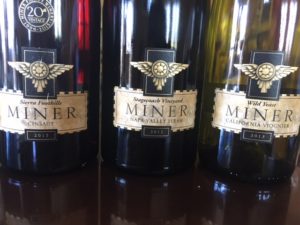 The Rhône-style white wine that has enjoyed longtime popularity at Miner Family is its viognier, which according to Dave, has been a Miner favorite since the late 90s. “The viognier has always sold really well, and it’s kind of caught on as a varietal,” he said of his winery’s version of the delicate, floral grape that stars in France’s great northern Rhône appellation of Condrieu. He added that marsanne was a much harder sell. “It was at a favorable price point and all that, but we were only able to move it because we didn’t make a lot of it.”
The Rhône-style white wine that has enjoyed longtime popularity at Miner Family is its viognier, which according to Dave, has been a Miner favorite since the late 90s. “The viognier has always sold really well, and it’s kind of caught on as a varietal,” he said of his winery’s version of the delicate, floral grape that stars in France’s great northern Rhône appellation of Condrieu. He added that marsanne was a much harder sell. “It was at a favorable price point and all that, but we were only able to move it because we didn’t make a lot of it.”
Miner’s tiny production of La Diligence marsanne from 2008 to 2011 mirrored its limited presence in California vineyards. There were a little over 100 acres of it planted here as of 2016, according to the California Department of Food and Agriculture, compared to sauvignon blanc’s 14,000 acres or chardonnay’s whopping 91,000 in that same year. At Dave’s winery, these latter two grapes fit respectively into the Bordeaux- and Burgundy-style portfolio without much additional explanation needed, at least for knowledgeable customers. And while many American consumers would be hard-pressed to name the Rhône Valley (let alone Condrieu) as the origin of viognier, this intriguing grape has taken on a robust and highly marketable identity of its own over the last 10 or 15 years. As an “alternative” white Rhône variety, on the other hand, marsanne is an outlier in California. But this didn’t deter Dave or Jack.
Soon after it was released in 2014, I sampled the last vintage of Stagecoach marsanne at a Bay Area trade tasting and found it a stunning wine—very pure, elegant, and varietally 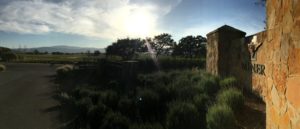 correct in the Rhône fashion of flowers, minerals, stone fruit, and the elusive “dried” honey characteristic that can be as familiar to marsanne enthusiasts as white pepper, violets, and bacon fat are to fans of northern Rhône syrah. It has only gotten better since. After taking a couple sips of the rich, complex wine in my glass that day upstairs at Miner, overlooking some of the world’s most pristine cabernet vines, I was reminded that the collective effort to coax a wine of great finesse from Stagecoach’s rocky soil—a white wine, no less—had been more than just noble. Even at this late date six-plus years since bottling, it had plenty of life and unique character left, reaffirming what I’d experienced a few years earlier: that I was tasting a Napa Valley wine with a Rhône Valley profile. That was, according to both guys, rather the point.
correct in the Rhône fashion of flowers, minerals, stone fruit, and the elusive “dried” honey characteristic that can be as familiar to marsanne enthusiasts as white pepper, violets, and bacon fat are to fans of northern Rhône syrah. It has only gotten better since. After taking a couple sips of the rich, complex wine in my glass that day upstairs at Miner, overlooking some of the world’s most pristine cabernet vines, I was reminded that the collective effort to coax a wine of great finesse from Stagecoach’s rocky soil—a white wine, no less—had been more than just noble. Even at this late date six-plus years since bottling, it had plenty of life and unique character left, reaffirming what I’d experienced a few years earlier: that I was tasting a Napa Valley wine with a Rhône Valley profile. That was, according to both guys, rather the point.
“I frickin’ adore this wine,” Dave practically blurted out, while his former sales director reminded me that he hadn’t tried it in a while. “For me, it might be a little fresher than a Rhône Valley marsanne,” Jack said. “It’s got higher acidity. But it’s also got a little bit of a bitter finish on the end, though not in a bad way, which marsanne is known for.”
“I love that about it,” Dave agreed. “It’s almost got that—it’s like a citrus peel flavor, almost like the pith!”
“And that’s so much like the Rhône Valley,” Jack observed, “because Rhône marsanne by itself always has that little bit of bitterness on the end. Like white Saint-Joseph, you know?”
[End of Part One]
